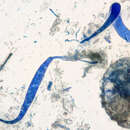Associations
provided by BioImages, the virtual fieldguide, UK
Foodplant / pathogen
amphigenous colony of Mycocentrospora anamorph of Mycocentrospora acerina infects and damages live leaf of Herbaceous Plants
Foodplant / spot causer
amphigenous colony of Mycocentrospora anamorph of Mycocentrospora acerina causes spots on live leaf of Arum maculatum
Foodplant / pathogen
amphigenous colony of Mycocentrospora anamorph of Mycocentrospora acerina infects and damages live leaf of Viola x wittrockiana (V. altaica x lutea x tricolor)
In Great Britain and/or Ireland:
Foodplant / pathogen
colony of Mycocentrospora anamorph of Mycocentrospora acerina infects and damages live, stunted, yellow stalk of Apium graveolens var. dulce
Foodplant / pathogen
colony of Mycocentrospora anamorph of Mycocentrospora acerina infects and damages live root of Pastinaca sativa ssp. sativa var. hortensis
Foodplant / pathogen
colony of Mycocentrospora anamorph of Mycocentrospora acerina infects and damages live root (crown) of Daucus carota ssp. sativus
Foodplant / spot causer
amphigenous colony of Mycocentrospora anamorph of Mycocentrospora acerina causes spots on live leaf of Acer campestre
Foodplant / spot causer
amphigenous colony of Mycocentrospora anamorph of Mycocentrospora acerina causes spots on live leaf of Acer platanoides
Foodplant / spot causer
amphigenous colony of Mycocentrospora anamorph of Mycocentrospora acerina causes spots on live leaf of seedling of Acer pseudoplatanus
Foodplant / spot causer
amphigenous colony of Mycocentrospora anamorph of Mycocentrospora acerina causes spots on live leaf of Ailanthus altissima
Foodplant / spot causer
amphigenous colony of Mycocentrospora anamorph of Mycocentrospora acerina causes spots on live leaf of Anemone nemorosa
Foodplant / pathogen
amphigenous colony of Mycocentrospora anamorph of Mycocentrospora acerina infects and damages live leaf of Beta vulgaris
Remarks: captive: in captivity, culture, or experimentally induced
Foodplant / pathogen
amphigenous colony of Mycocentrospora anamorph of Mycocentrospora acerina infects and damages live leaf of Brassica oleracea
Remarks: captive: in captivity, culture, or experimentally induced
Foodplant / pathogen
amphigenous colony of Mycocentrospora anamorph of Mycocentrospora acerina infects and damages live leaf of Callistephus chinensis
Remarks: captive: in captivity, culture, or experimentally induced
Foodplant / pathogen
amphigenous colony of Mycocentrospora anamorph of Mycocentrospora acerina infects and damages live leaf of Impatiens parviflora
Foodplant / pathogen
amphigenous colony of Mycocentrospora anamorph of Mycocentrospora acerina infects and damages live leaf of Daucus carota
Remarks: captive: in captivity, culture, or experimentally induced
Foodplant / pathogen
amphigenous colony of Mycocentrospora anamorph of Mycocentrospora acerina infects and damages live leaf of Lycopersicon esculentum
Remarks: captive: in captivity, culture, or experimentally induced
Foodplant / pathogen
amphigenous colony of Mycocentrospora anamorph of Mycocentrospora acerina infects and damages live leaf of Malcolmia maritima
Remarks: captive: in captivity, culture, or experimentally induced
Foodplant / pathogen
amphigenous colony of Mycocentrospora anamorph of Mycocentrospora acerina infects and damages live leaf of Pastinaca sativa
Remarks: captive: in captivity, culture, or experimentally induced
Foodplant / pathogen
amphigenous colony of Mycocentrospora anamorph of Mycocentrospora acerina infects and damages live leaf of Petroselinum crispum
Foodplant / pathogen
amphigenous colony of Mycocentrospora anamorph of Mycocentrospora acerina infects and damages live leaf of Petunia axillaris x integrifolia (P. x hybrida)
Remarks: captive: in captivity, culture, or experimentally induced
Foodplant / pathogen
amphigenous colony of Mycocentrospora anamorph of Mycocentrospora acerina infects and damages live leaf of Picea sitchensis
Foodplant / pathogen
amphigenous colony of Mycocentrospora anamorph of Mycocentrospora acerina infects and damages live leaf of Pisum sativum
Remarks: captive: in captivity, culture, or experimentally induced
Foodplant / pathogen
amphigenous colony of Mycocentrospora anamorph of Mycocentrospora acerina infects and damages live leaf of Potamogeton nodosus
Foodplant / pathogen
amphigenous colony of Mycocentrospora anamorph of Mycocentrospora acerina infects and damages live leaf of Potentilla palustris
Foodplant / pathogen
amphigenous colony of Mycocentrospora anamorph of Mycocentrospora acerina infects and damages live leaf of Spiraea media
Foodplant / pathogen
amphigenous colony of Mycocentrospora anamorph of Mycocentrospora acerina infects and damages live leaf of Stellaria holostea
Foodplant / pathogen
amphigenous colony of Mycocentrospora anamorph of Mycocentrospora acerina infects and damages live leaf of Ulmus scabra
Foodplant / pathogen
amphigenous colony of Mycocentrospora anamorph of Mycocentrospora acerina infects and damages live leaf of Verbena x hybrida
Remarks: captive: in captivity, culture, or experimentally induced
Foodplant / pathogen
amphigenous colony of Mycocentrospora anamorph of Mycocentrospora acerina infects and damages live leaf of Viola cornuta
Remarks: captive: in captivity, culture, or experimentally induced
Foodplant / pathogen
amphigenous colony of Mycocentrospora anamorph of Mycocentrospora acerina infects and damages live leaf of Viola tricolor
Remarks: captive: in captivity, culture, or experimentally induced
Mycocentrospora acerina: Brief Summary
provided by wikipedia EN
Mycocentrospora acerina is a deuteromycete fungus that is a plant pathogen.
- license
- cc-by-sa-3.0
- copyright
- Wikipedia authors and editors

